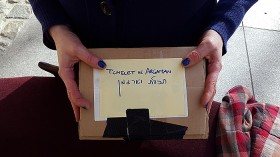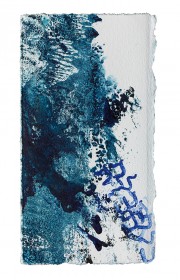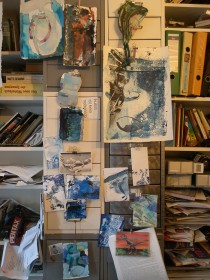
When delivering her art works to the Jewish Museum Berlin, Deborah S. Phillips naturally wears blue nail polish © Jewish Museum Berlin. Photo: Gelia Eisert
A visit to Berlin-Neukölln, to the studio apartment of Deborah S. Phillips, who is dressed in blue, today, except for her shoes, which are green. That the artist has spent the last five years examining the color blue and is only now gradually turning her attention to hues of green is reflected thus in her apparel as well as her art.
Red was the first color to which Deborah Phillips devoted herself with a passion. The Bible story she read aloud as a 12-year-old in the synagogue on the occasion of her Bat Mizwa was about the red cow—and it haunted her for ages. It was the tale of a strange animal that had to be sacrificed so people could use its ashes to cleanse themselves of sin. Only then would they be able to enter the temple in Jerusalem. Many years later, Deborah Phillip’s reflections on the color red and its cultural significance culminated in one of her enchanting works on paper, the “Red Book,” which is the fruit also of the artist’s extensive voyages in Iran, India and Central Asia, and her affinity with Islamic cultures.

“Tchelet ve Argaman,” lithograph & rubber stamp print, Deborah S. Phillips, 2015 © Jewish Museum Berlin, photo: Claudia Rannow
In the meantime there is a “Blue Book” too. On my visit I was allowed to leaf through the freshly finished art books, seven unique editions in all. Compiled therein are lithographs, monotypes, photo collages, lead-type-set text, block prints, and small drawings executed in nail varnish of every conceivable shade of blue.
Deborah Phillips’s fascination with the color blue is likewise of Biblical origin. The fourth Book of Moses bids the faithful to sew threads onto the four corners of their prayer cloak as a constant reminder of the Lord’s commandments. Some of the threads, it is said, should be dyed blue or “tchelet,” to use the Hebrew term. Since it was impossible to say exactly which shade of blue was meant, scholars later revoked this precept and ordained the use of white thread instead. Rabbinical discussions about “tchelet” occupied Deborah already when she was a girl. Nowadays, in Israel, the secular yet supernal term “tchelet” describes merely the color of the sky.

“Tchelet Fragments,” lithograph, monotype & rubber stamp print, Deborah S. Phillips, 2014 © Jewish Museum Berlin, photo: Jens Ziehe
Colors and sounds, letters of the alphabet, spices and smells: all these flow together in Deborah Phillips’s artistic practice—and what may thereby eventually transpire is as much a mystery to her as to anyone. Her work on the “Blue Book” gave rise, quasi as a byproduct, to the monotypes which are available in our Art Vending Machine in the permanent exhibition at the Jewish Museum Berlin. On half of the small works-on-paper, the artist stamped a single Hebrew word, namely “tchelet”; on the others she stamped the word “argaman.” This second word means “purple,” a royal color once worn by priests in the ancient temples of Jerusalem.
In addition to her works on paper, Deborah Phillips creates films, installations and performances. She works as a translator, coordinates cultural projects, and is an excellent cook as well as a “spice consultant.”
By the way, not only colors play a major role in the (artistic) life of Deborah Phillips but also an infamous street in Neukölln, the Hermannstraße. For her mother’s maiden name was Hermann and the artist herself has lived in the Hermannstraße/ Hermannplatz neighborhood for many years. This coincidence prompted a project with the title HERMAN(N).
Colors, odors, voices and sounds, delicate, dazzling and wild, accompanied me on my way from Deborah’s studio apartment to the subway, down Hermannstraße.
Maren Krüger visited the artist Deborah S. Phillips in her studio apartment in Berlin-Neukölln.
P.S.: Further information about the artwork and the other artists of the art vending machine can be found here.
